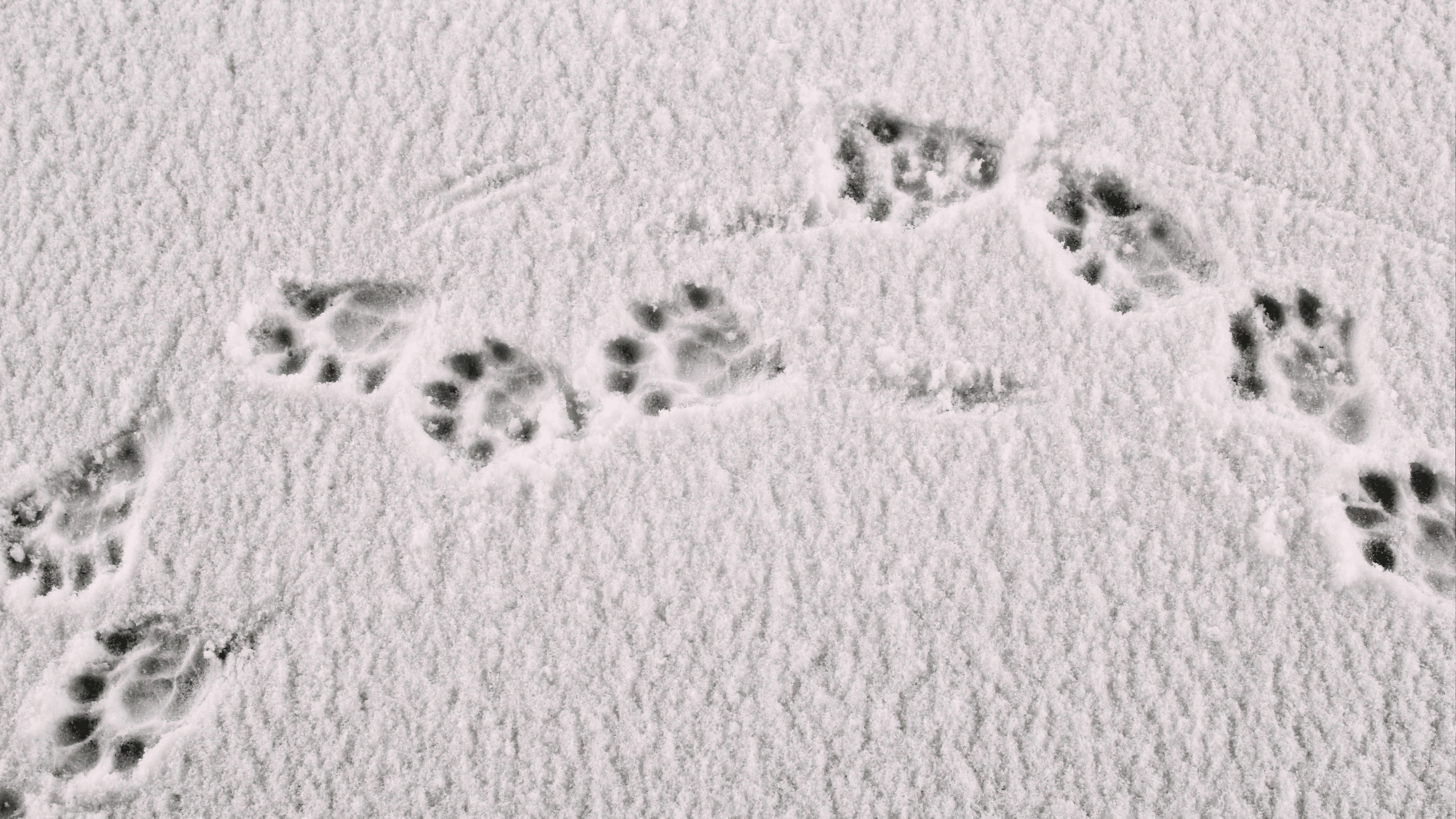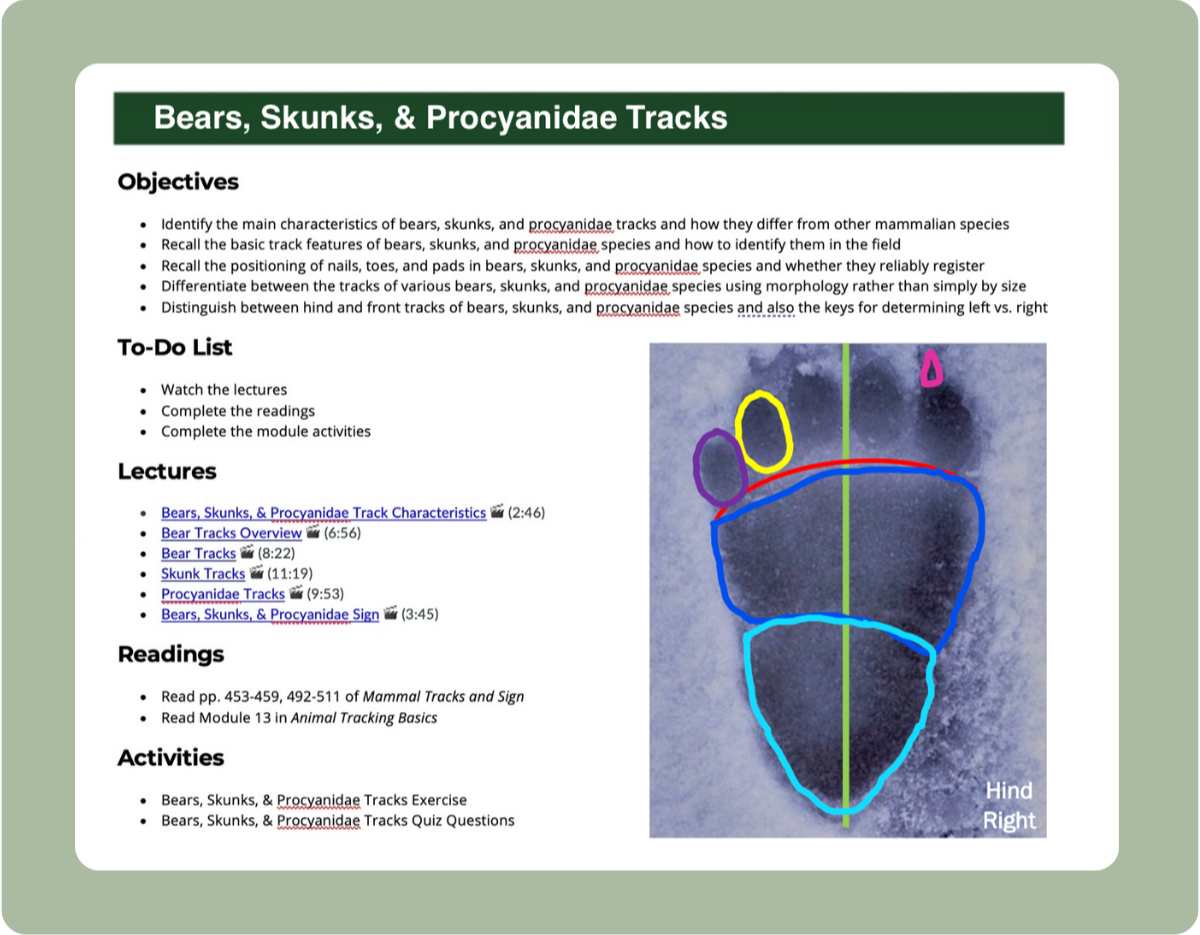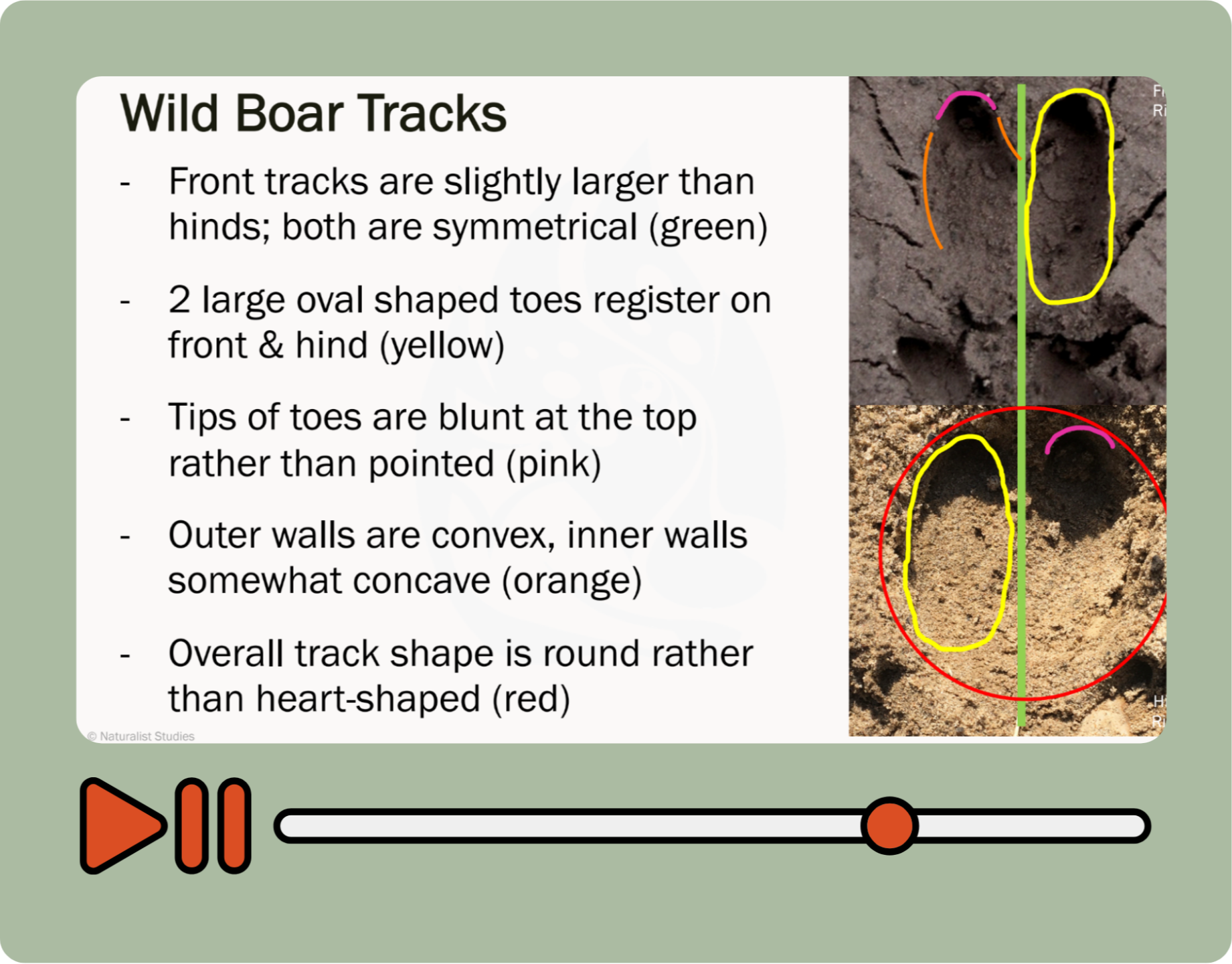Become a Wildlife Tracking Expert

What You'll Learn
🐾 Track Recognition: Master the skill of identifying animal footprints by using proven methods to analyze the characteristics and unique features for any species.
🚸 Animal Sign: Discover how to find and read the evidence of an animal's presence in an area including feeding, resting, marking, nesting, rooting, scat, urine, and other sign.
🐻 Wildlife Behavior: Interpret what animal tracks, gaits, and other clues reveal about an individual's movements, intentions, and state of mind.
🎯 Advanced Skills: Age tracks, follow trails, and analyze predation events with techniques used by scientists and professional trackers.
Benefits
📸 Incredible Wildlife Moments: Locate and observe animals in close quarters without creating disturbance or having them know you are there.
🌿 Deepen Your Connection to Nature: Gain a profound appreciation for the intricate details of animal life, making every outing a meaningful experience.
🧘♂️ Rejuvenate Your Mind and Spirit: Transform your time outdoors into a stress-relieving adventure that fosters inner peace and mindfulness.
Why Choose Us?
🧭 Expert Instruction: Our lectures and other course materials are the same as those used in classes at elite universities to train professional biologists.
🌟 Proven Results: Hundreds of students have enhanced their outdoor skills through our programs—many using their newfound expertise in wildlife jobs or conservation efforts.
📚 Comprehensive Curriculum: Includes video lectures, analysis exercises, quizzes, and flashcard examples giving you the all the tools needed to become a master tracker.
What Our Tracking Students Have To Say...
Adam Brightman ⭐⭐⭐⭐⭐
"I am in law enforcement and did not realize how successful I became with the content of this course until I took one of my fellow environmental police officers with me. As I explained to him what I was looking at with the deer tracks, he simply looked at me in amazement and said 'Where did you learn all of this?' It was at this moment that I realized I had obtained a skillset that a senior game warden did not possess."
Alexis Tays ⭐⭐⭐⭐⭐
"It is truly amazing how much you can experience in nature when you are fully aware of your surroundings and how that can change your entire experience of the great outdoors. This course turned my walks in the parks into scavenger hunts that made me feel like Sherlock Holmes; analyzing and speculating every track and sign I saw, trying to piece together the puzzle of what the wildlife was doing and why...it encouraged me to slowdown when outdoors and gave me a greater appreciation of the shared spaces we have with wildlife, even just in my backyard."
Savannah Troy ⭐⭐⭐⭐⭐
“The most fascinating part of becoming familiar with tracking skills has been realizing how much information about a landscape I was missing out on before I knew where and how to look for it. I had conducted research..and the areas where I was now finding tracks and sign are places I have spent dozens to hundreds of hours in and am intimately familiar with...despite this familiarity, I was still surprised and able to see each area with a new perspective...and it was fascinating to see places I know so well in a new light.”
Joel Conrad ⭐⭐⭐⭐⭐
“I work in conservation law enforcement and on multiple occasions in the past few months I have directly used knowledge gained in this class to some beneficial result in the field, catching things I would not have seen before. In one instance, I tracked an individual well over a mile into the woods and and charged him with federal and state violations for an unlawful killing of an animal."
Tim James ⭐⭐⭐⭐⭐
“My favorite thing about this course is that it has made me slow down and notice so many animal signs when I am out hiking/running/fishing, etc. I feel like it has made me so much more aware, and enabled me to enjoy my outdoor outings much more!”
Get Our Comprehensive Product:
Wildlife Tracks & Sign Full Course

*Comprises all three component courses (basic, intermediate, and advanced).
Topics Covered:
🐾 Identifying Wildlife Tracks
Learn to analyze and identify the tracks for over 60 species of predators and prey, including the major classes of animal like mammals, birds, reptiles, and amphibians.
🚸 Recognizing Animal Sign
Determine the species responsible for a wide variety of animal sign like feeding, bedding, denning, marking, scat/pellets, rooting, digging, predation remains, and more.
⏳ Aging Tracks & Sign
Master the techniques required to accurately age the tracks and sign of animals in order to understand when an animal was present in a particular area.
🐎 Deciphering Animal Gaits
Discover the keys to identifying the movement patterns of animals and how that relates to their behavior and intentions at a given time/place and where they might be now.
👣 Following Animal Trails
Spot animal pathways and learn to recognize fresh trails, staying on them until you find the animal you are following.
Or Choose a Smaller Product:
Wildlife Tracks & Sign Individual Courses

Basic Course
Topics Covered:
🌿 Introduction to Animal Sign: Learn to spot subtle clues animals leave behind.
🔍 Tracking Morphology & Ecology: Understand the science behind tracking.
🐕 Canine Tracks: Identify wolves, coyotes, foxes, and domestic dogs.
🐈 Feline Tracks: Recognize lions, bobcats, and more.
🦌 Ungulate Tracks: Master deer, elk, and wild boar tracking.

Intermediate Course
Topics Covered:
🐻 Bears, Skunks, & Procyonidae: Distinguish these unique tracks in the wild.
🦊 Medium-Sized Mammals: Track otters, badgers, porcupines, and more.
🐿️ Rodent Tracks: Identify over a dozen rodent species.
🐦 Bird Tracks: Recognize the trails of songbirds, predators, and waterfowl.
🦎 Reptile & Amphibian Tracks: Spot lizards, snakes, and frogs in any terrain.

Advanced Course
Topics Covered:
💩 Scat & Pellets: Analyze animal diets and health from their droppings.
🦶 Other Animal Signs: Recognize feeding, nesting, and predation events.
⏳ Aging Tracks: Master techniques for estimating track timelines.
🏃 Animal Gaits: Understand movement patterns and behavioral clues.
👣 Trailing Animals: Follow and observe wildlife without disturbing their habitats.
Course Learning Materials


📋 Detailed Lesson Outlines
Each topic comes with specific objectives and recommended tasks to help you stay on track, keep you organized, and help you retain what you learn.



🎥 In Depth Video Lectures
Dive into hours of expert video lessons covering the fundamentals of wildlife tracking as well as the finer details of how to identify the tracks and sign of individual species.



✅ Interactive Quizzes
Test your knowledge of fundamental concepts in the video lectures with questions that are designed to not only validate your grasp of broad concepts, but also reinforce important details.



🔍 Guided Tutorials
Strengthen your understanding with step-by-step exercises that break down and analyze key aspects of lesson objectives, allowing you to actually put into practice what you have learned.



🃏 Flashcard Exercises
Boost your engagement and long-term retention with flashcards that you can review whenever you like, allowing you to continually enhance your learning for as long as you want.



🤝 Naturalist Speak
Share your tracking adventures by posting photos to the community, get help in identifying the tracks and animal sign you don't recognize, and engage in discussions.


We're so sure that you'll love Wildlife Tracks & Sign that we're offering an outrageous guarantee: You have 14 days after the course starts to change your mind and ask for a refund. No hassle, no questions asked, no hard feelings!
Wildlife Tracks & Sign Courses

Meet Your Instructor

Lee Burton
Known as The Outside Professor, Lee is the founder of Naturalist Studies and an adjunct instructor at the University of Florida and Texas A&M, where he teaches animal behavior courses.
He is certified in Wildlife Track and Sign by CyberTracker Conservation, is a Master Naturalist, and mentored under Jon Young, the founder of the Wilderness Awareness School. Lee is also recognized as a Bird Language Leaders Instructor.
His passion for wildlife ultimately led him to become the director for Conservation Centers for Species Survival, where he was profiled on Steve Rinella's Meateater podcast for his role in reintroducing the Scimitar-horned Oryx to sub-Saharan Africa.
Lee grew up in a small town in Texas where easy access to nature led to a love of the outdoors, instilled in him by his father and other relatives who taught him how to hunt and fish. As he matured, his curiosity about the natural world deepened, leading him to study animals, plants, and ecology in some of the most remote places in Asia, Africa, and South America. While these experiences heightened his understanding of the world's fauna and flora, he yearned for a deeper connection with nature.
Upon returning to the United States, Lee delved into Traditional Ecological Knowledge (TEK), learning ancient skills like animal tracking, bird language interpretation, and wilderness survival. Developing these skills was a game-changer, allowing him to see nature in a whole new light and realize that he was an integral part of the natural world, not just an observer.
Let’s hear it from Lee himself:
“Before learning wildlife tracking, I had a wealth of scientific knowledge but struggled to understand the way animals think. I couldn’t get inside their heads to know where they would be, what their motivations were, or predict their movements. I felt like an outsider, always on the edge of their world, but never truly part of it.
After learning tracking, I could step into any outdoor setting—whether it was my own property, a local park, or deep in the wilderness—and read the tracks and signs around me. I began to understand not just who was there, but why they were there, and what they were doing. Over time, I started being able to think like the animals I was pursuing, predicting their movements, and understanding their behavior. It was as if I had been welcomed into their private world, where all their secrets were laid bare. This not only made me a more capable hunter, but also a better naturalist, and in the process transforming my wildlife adventures while deepening my connection to nature.
A few years later, a biology professor friend of mine asked if I would teach animal tracking to her students. The course I created became an instant hit, with students describing it as their favorite class. This success led to the development of other courses and the founding of Naturalist Studies, where I wanted to share this knowledge with a broader audience.
Now, I’m thrilled to offer these same learning materials to others. I’m deeply grateful for the opportunity to teach these skills and share this journey with you, as I believe that this course will fundamentally change your outdoor experiences forever, helping you see the wild in a way you never have before.”
Frequently Asked Questions
What learning materials are included?
Do I have lifetime access to the course?
Is there a money-back guarantee?
Can I post my own track and sign photos/videos to the Naturalist Speak community?
Can I be new to tracking, or is the course only for people with previous experience?
What animal groups are covered in the full course?
I live outside North America; will the material still be relevant?
I am an experienced outdoorsman already, is the full course worth the investment?
Will the full course help me become a better hunter?
I want to know more about animal behavior; will the course help me?
Is this course appropriate for my son or daughter?

